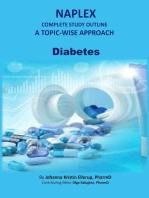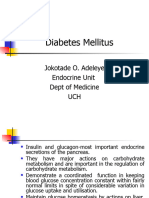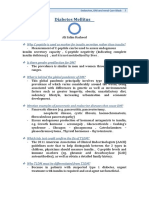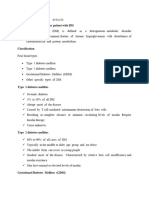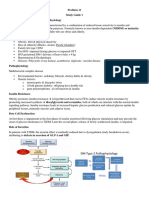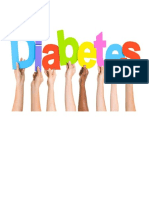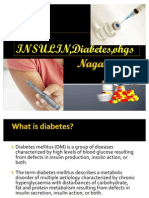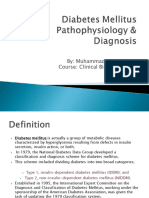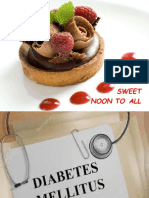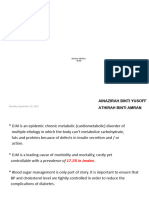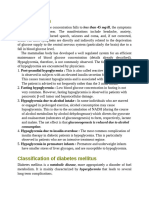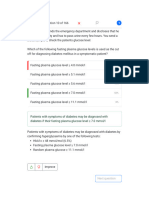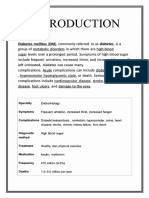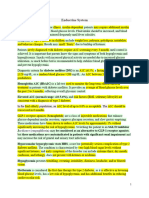0 ratings0% found this document useful (0 votes)
20 viewsCurs Studenti Straini
Curs Studenti Straini
Uploaded by
Alexandru VisanCopyright:
© All Rights Reserved
Available Formats
Download as PPT, PDF, TXT or read online from Scribd
Curs Studenti Straini
Curs Studenti Straini
Uploaded by
Alexandru Visan0 ratings0% found this document useful (0 votes)
20 views71 pagesCopyright
© © All Rights Reserved
Available Formats
PPT, PDF, TXT or read online from Scribd
Share this document
Did you find this document useful?
Is this content inappropriate?
Copyright:
© All Rights Reserved
Available Formats
Download as PPT, PDF, TXT or read online from Scribd
Download as ppt, pdf, or txt
0 ratings0% found this document useful (0 votes)
20 views71 pagesCurs Studenti Straini
Curs Studenti Straini
Uploaded by
Alexandru VisanCopyright:
© All Rights Reserved
Available Formats
Download as PPT, PDF, TXT or read online from Scribd
Download as ppt, pdf, or txt
You are on page 1of 71
DIABETES_ LECTURE
PROF. DR. DOINA CATRINOIU
Diabetes Mellitus
One of the most common non-
communicable diseases
Fourth leading cause of death in most
developed countries
More than 194 million people with
diabetes worldwide
Incidence of diabetes is increasing
estimated to rise to 333 million by 2025
To more than double in Africa, the Eastern
Mediterranean and Middle East, and South-East Asia
To rise by 50% in North America, 20% in Europe,
85% in South and Central Americas and 75% in the
Western Pacific
: International Diabetes Federation website
Types of Diabetes Mellitus
Type 1 diabetes (insulin-dependent
diabetes)
mainly in childhood/early adult life
10-20% of cases
Type 2 diabetes (non-insulin-dependent
diabetes)
usually develops in the middle-age/elderly
incidence increasing at a younger age
80-90% of cases
At least 50% of all people with
diabetes are unaware of their
condition
: International Diabetes Federation website
CLASSIFICATION OF DIABETES
Impaired glucose tolerance without
diabetes (IGT)
Primary diabetes mellitus
Insulin dependent (IDDM or Type 1)
Noninsulin dependent (NIDDM or Type 2)
Malnutrition-related diabetes mellitus
(MRDM)
Secondary diabetes mellitus
Pancreatic disease
Endocrine disorders
Drug therapy
Inherited disorders
Secretia de insulina
Synthesis of insulin
ESR10-08
S
S
S
S
HOOC
S
S
NH
2
Proinsulin (86aa)
Synthesis of insulin
ESR10-09
S
S
S
S
HOOC
S
S
NH
2
Insulin (21 + 30aa)
HOOC
NH
2
- chain
- chain
C - peptide (35aa)
Basal-bolus therapy attempts to re-
create physiological insulin secretion
P
r
e
d
i
c
t
e
d
p
l
a
s
m
a
i
n
s
u
l
i
n
c
o
n
c
e
n
t
r
a
t
i
o
n
p
r
o
f
i
l
e
(
m
U
/
l
)
Time of day
Rapid-acting insulin
Basal insulin
Total
Diabetes is defined biochemically
by the following criteria
A fasting venous plasma glucose
level greater than 7.8 mmol/litre
(126 mg/dl) on more than one
occasion;
or A 2-hour (plus one other)
venous plasma glucose level in
excess of 11.1 mmol/litre (200
mg/dl) in a formal 75 g oral
glucose tolerance test (GTT).
Clinical features of diabetes at
diagnosis
Type 1 Type 2
Polyuria and thirst ++ +
Weakness or fatigue ++ +
Polyphagia with weight loss++
Recurrent blurred vision + ++
Vulvovaginitis or pruritus + ++
Peripheral neuropathy + ++
Nocturnal enuresis ++
Often asymptomatic ++
DIABETES
Fasting plasma glucose
109-125 mg/dl
postprandial plasma
glucose > 200mg/dl
Classical
Symptoms* +
Blood glucose > 200 mg/dl
Fasting plasma glucose
> 126 mg/dl
2-h Plasma glucose after
"OGTT" > 200 mg/dl
and/or
Fasting plasma glucose >
126 mg/dl
Blood glucose 100 -200 mg/dl
A diagnostic algorithm for diabetes
mellitus
Blood glucose > 200 mg/dl
"occasionally"
A
S
Y
M
P
T
O
M
A
T
I
C
INVESTIGATIONS
Blood glucose is the key to diagnosis in
diabetes.
Glycosylated haemoglobin and other
proteins: measurement of these proteins
reflects the degree of diabetic control in
the previous 4-6 weeks and is of value in
long-term management and control .
INVESTIGATIONS
Urine testing for glucose-glucose will
be found in the urine only when it rises
above the renal threshold (usually about
10 mmol/l
Urine testing for ketone bodies the
presence of ketones suggests loss of
control.
Proteinuria is a reflection of the
development of renal complications and
is an early indicator of diabetic renal
disease Multiple test strips allow rapid
testing for all these substancesin urine.
INVESTIGATIONS
Proteinuria is a reflection of the
development of renal complications and
is an early indicator of diabetic renal
disease Multiple test strips allow rapid
testing for all these substancesin urine.
Microalbuminuria is a very sensitive
marker of early and potentially reversible
renal impairment; it is the term given to
the presence of protein below the level of
detection with the stick methods, that is
200 mg/litre.
INVESTIGATIONS
Serum electrolytes, blood gases,
osmolality and anion gap are all of
value in metabolic crises if there is
loss of water, sodium and potassium
and acidosis is developing, or if there
is a hyperosmolar state.
Lipid profile: elevations in serum
cholesterol are common, and
elevation of serum triglycerides is a
reflection of poor glycaemic control,
which usually reverts to normal when
euglycaemia is achieved.
PRESENTING FEATURES OF DIABETES
Acute: the typical presentation of the young
patient with IDDM; features include polyuria,
polydipsia and weight loss of short duration,
often associated with, or apparently
precipitated by, a viral infection;visual
disturbance or impairment of the conscious
level associated with severe ketoacidosis
Chronic: the typical presentation of a patient
with NIDDM; the symptoms have usually been
present for some months and often include
weight loss, thirst, excess urine volume, genital
and skin infections
PRESENTING FEATURES OF DIABETES
Coincidental discovery: routine
screening for urine or blood glucose as
part of a pre-employment medical, during
pregnancy or in local campaigns
Complications: visual disturbance or
overt retinopathy, neuropathy,
nephropathy or after major thrombotic
events such as premature stroke or
myocardial infarction
PRESENTING FEATURES OF DIABETES
Drug-related diabetes may develop in
patients on long-term steroids or thiazide
diuretics
Disease-related as in acromegaly,
Cushing's syndrome,
phaeochromocytoma, thyrotoxicosis,
pancreatitis, haemochromatosis, cystic
fibrosis, carcinoma or surgical removal of
the pancreas
Gestational: pregnancy may unmask
diabetes in a woman who is predisposed.
A full history and clinical examination are
essential to detect any of the causative
diseases and document the consequences.
PRESENTING FEATURES OF DIABETES
Patients with type 2 diabetes may
or may not have characteristic
features. The presence of obesity
or a strongly positive family
history for mild diabetes
suggests a high risk for the
development of type 2 diabetes.
DM Kendall et al. Eur J Intern Med 20, ( 2009) S329S339
Prin amabilitatea Prof. Dr. N. Hncu
Adapted from IDC, Minneapolis
Diabetes duration (years)
-20
-10 0
10 20 30
Obesitate IGT Diabet [necontrolat]
Postprandial
Fasting
insulinorezistenta
Insulin Level
Treatmentul DZ tip 2: inlocuirea deficitului
Glicemia
(mg/dl)
Functia
-celulara
(%)
126
100
The Progression from CV Risk Factors to
Endothelial Injury and Clinical Events
Risk factors
Oxidative stress
Endothelial dysfunction
NO Local mediators Tissue ACE-Ang II
PAI-1 VCAM
ICAM cytokines
Endothelium Growth factors
matrix
Proteolysis
LDL-C BP Heart failure Smoking Diabetes
Vasoconstriction
Vascular lesion
and remodelling
Plaque rupture Inflammation Thrombosis
Clinical endpoints
NO Nitric oxide
Gibbons GH, Dzau VJ. N Engl J Med 1994;330;1431-1438.
The Metabolic Syndrome and
Associated CVD Risk Factors
Insulin
Resistance
Atherosclerosis
Endothelial
Dysfunction
Hypertension
Abdominal obesity
Hyperinsulinaemia
Dyslipidaemia
high TGs
small dense LDL
low HDL-C
Diabetes
Hypercoagulability
Deedwania PC. Am J Med 1998;105(1A);1S-3S.
NCEP ATP III: The Metabolic
Syndrome
<40 mg/dL (1.0
mmol/L)
<50 mg/dL (1.3
mmol/L)
Men
Women
>102 cm (>40 in)
>88 cm (>35 in)
Men
Women
110 mg/dL (6.0
mmol/L)
Fasting glucose
130/85 mm Hg Blood pressure
HDL-C
150 mg/dL (1.7
mmol/L)
TG
Abdominal obesity
(Waist circumference)
Defining Level Risk Factor
Recommends a diagnosis when 3 of these risk factors are present
NCEP, Adult Treatment Panel III, 2001. JAMA 2001:285;2486-2497.
WHO: The Metabolic Syndrome
A working definition is glucose intolerance, IGT or
diabetes mellitus and/or insulin resistance together
with two or more of the following:
Raised arterial pressure 160/90 mmHg
Raised plasma triglycerides (1.7 mmol/L, 150
mg/dL) and/or low HDL-C (men <0.9 mmol/L,
35 mg/dL; women <1.0 mmol/L, 39 mg/dL)
Central obesity
Microalbuminuria (UAER 20 g/min or
albumin: creatinine ratio 20 mg/g)
Alberti KGMM for the WHO. Diabet Med 1998:15;539-553.
TREATMENT
Type 1 diabetes ONLY INSULIN is a
replacement therapy
Type 2 diabetes ORAL DRUGS+/-
INSULIN THERAPY
NPH insulin has been with us a long time
How should we address the limitations
of old technology?
Limitations of NPH: a relatively short action
profile with a peak
GIR, glucose infusion rate; GIR curves adapted from references; NPH, neutral protamine Hagedorn
Heise et al. Diabetes 2004;53:161420
Limitations of NPH: an action profile with
variability, injection to injection
GIR, glucose infusion rate;
NPH, neutral protamine Hagedorn
Human insulins do not closely match the
endogenous insulin response
Adapted from: Polonsky et al. J Clin Invest 1988;81:4428
Insulin analogues address the limitations of
human insulin
Adapted from: Polonsky et al. J Clin Invest 1988;81:4428
What would the ideal basal insulin look like?
Soluble at neutral pH to avoid variability
problems associated with:
Resuspension of re-formed crystals
Precipitation and redissolution of
subcutaneous precipitates
Kinetic profile
Long-acting for minimal injection frequency
Peak-less to reduce risk of nocturnal
hypoglycaemia
Predictable and reproducible to aid titration,
control and tolerability
Strategy for engineering analogue safety: the
importance of molecular design
The following important factors are always
considered when developing new insulin
analogues:
IGF-1 receptor affinity relative to human IR
affinity should not be higher than for human
insulin
Insulin dissociation/off-rate from the IR should
be similar to that of human insulin
The mitogenic/metabolic potency ratio should
not exceed 1
IGF-1, insulin-like growth factor 1; IR, insulin receptor
Potential sites for modification of
insulin
Kaarsholm and Ludvigsen. Receptor 1995;5:18
Molecular modifications of insulin
analogues
Kaarsholm and Ludvigsen. Receptor 1995;5:18
Pires and Chacra. Arq Bras Endocrinol Metabol 2008;52:26878
The structure of insulin detemir
monomer
Whittingham. Biochemistry 1997;36:2826
Insulin detemir: a unique
mechanism of protraction
Protraction mechanism of insulin
detemir
1. Self-association at injection
depot
Whittingham et al. Biochemistry 1997;36:282631
Albumin-binding affinity
correlates with absorption rate
Markussen et al. Diabetologia 1996;39:2818
Albumin-binding buffers against changes in
absorption rate
Kurtzhals. Int J Obes Metab Disord 2004;28(Suppl. 2):S23S28
NPH, neutral protamine Hagedorn
Insulin detemir: three mechanisms for a
prolonged action profile
Glucose clamp: manual set-up
Glucose clamp: automated set-up
NPH insulin results in substantial intra-
injection variability
Heise et al. Diabetes 2004;53:161420
Type 1 diabetes
GIR, glucose infusion rate;
NPH, neutral protamine Hagedorn
Variability and peak profile for NPH and
insulin glargine
Heise et al. Diabetes 2004;53:161420
GIR, glucose infusion rate;
NPH, neutral protamine Hagedorn
Type 1 diabetes
Variability refers to
fluctuations in an
individual patients
BG levels (intra-
patient), and
variations between
different patients BG
levels (inter-patient)
Inter- versus intra-patient blood
glucose (BG) variability
Monnier et al. J Diabetes Sci Technol 2008;2(6):1094100
Mean glucose concentration in 32 non-insulin-using patients
with type 2 diabetes exhibiting HbA
1c
levels between 7% and
7.9%
Defining glucose variability
Hypoglycaemic events
Postprandial glucose excursions
Minor fluctuations in blood glucose levels
Monnier and Colette. Diabetes Care 2008;31(Suppl.2):S1504
Variability: a third measure of glycaemia?
FPG, fasting plasma glucose; MAGE, mean amplitude of glucose excursions;
PPG, postprandial glucose
Monnier et al. J Diabetes Sci Technol 2008;2:1904100
Nonglycemic effects of oral therapy
Cardiovascular
risk factor
Sulfonil
urea
Rapid-
acting
insulin
secretago
gues
Metfor
min
Thiazolidindi
ones
-
glucosida
se
inhibitors
Insulin resistance
Hyperinsulinemia
LDL chol levels
LDL particle pattern
HDL chol levels
Triglycerides
LP (a)
PAI-1
Endothelial function
Body weight
Visceral adiposity
0
0
0
0
0
0
0
0
0
0
0
0
0
0
0
0
0
0
?
?
0
or 0
Large buoyant
0 or
0
0
0
0
0
0
0
0
0
0
Modified fromHE Lebovitz, Endocrinol clin North Am, 2001, 30: 909-933
Potential down-sides of pharmacological
treatment modalities in patients with T2DM
Potential problem Avoid or reconsider
Unwanted weight gain
Gastrointestinal symptoms
Hypoglycemia
Impaired kidney function
Impaired liver function
Impaired cardio-pulmonary
function
Sulphonylureas, glinides,
glitazones, insulin
Biguanides, alpha-glucosidase
inhibitors
Sulphonylureas, glinides,
insulin
Biguanides, sulphonylureas
Glinides, glitazones, biguanides,
alpha-glucosidase
Biguanides, glitazones
ESC, EASD Guidelines, 2007
Suggested policy for the selection of glucose-
lowering therapy according to the glucometabolic
situation
Post-prandial
hyperglycemia
Fasting hyperglycemia
Insulin resistance
Insulin deficiency
alpha-glucosidase inhibitors, short-
acting SU, glinides, short-acting regular
insulin or insulin analogs
Biguanides, long-acting SU, glitazones,
long-acting insulin or insulin analogs
Biguanides, glitazones, alpha-
glucosidase inhibitors
SU, glinides, insulin
ESC, EASD Guidelines, 2007
Adapted from Rosenstock J, Riddle MC. Chapter 9: Insulin therapy in type 2 diabetes. In: Cefalu
WT, Gerich JE, LeRoith D (eds). The CADRE Handbook of Diabetes Management. New York:
Medical Information Press; 2004:14568.
Persistent HbA
1c
>7%
Revisit T2DM treatment strategies:
the evolving HbA
1c
position
Achieving and maintaining HbA
1c
at target may require
incremental and combination therapies
Treat-to-target concept
Realistic target:
lowest HbA
1c
possible without
unacceptable hypoglycaemia
Healthy individual HbA
1c
46%
ACTION
Summary of antidiabetic interventions as
monotherapy
Interventions Expected
decrease
in A1c
(%)
Advantages Disadvantages
Step 1: initial
Lifestyle to decrease weight
and increase activity
Metformin
Step 2: additional therapy
Insulin
Sulphonylureas
TZDs
Other drugs
-glucosidase inhibitors
Exenatide
Glinides
Pramlintide
1-2
1.5
1.5-2.5
1.5
0.5-1.4
0.5-0.8
0.5-1.0
1-1.5
0.5-1.0
Low cost, many
benefits
Weight neutral,
inexpensive
No dose limit,
inexpensive,
improved lipid profile
Inexpensive
Improved lipid
profile
Weight neutral
Weight loss
Short duration
Weight loss
Fails for most in first year
GI side effects, rare lactic
acidosis
Injections, monitoring,
hypoglycemia, weight gain
Weight gain, hypoglycemia
Fluid retention, weight
gain, expensive
Frequent GI side effects,
expensive
Injections, frequent GI side
effects, expensive, little
experience
3x/ day dosing, expensive
Injections, frequent GI side
effects, expensive, little
experience
A consensus statement from ADA and EASD. Diabetologia, 2006, 49: 1711-21
Diagnosis
Lifestyle intervention + metformin
Add basal insulin
-most efective
Add sulfonylurea
-least expensive
Add glitazone
-no hypoglycamia
HbA1C7% HbA1C7% HbA1C7%
HbA1C7
%
Intensify insulin Add glitazone Add basal insulin Add sulfonylurea
HbA1C7% HbA1C7%
Add basal or intensify insulin
Intensive insulin + metformin +/- glitazone
A consensus statement from ADA and EASD. Diabetologia, 2006, 49: 1711-21
Algorithm for the metabolic management of T2DM
Strategii si algoritmuri
Management of hyperglycemia in type 2 diabetes
How do I establish and sustain glycemic control?
Lifestyle change: an
option?
Is metformin still the
first line drug?
Which drugs after
metformin?
Sulphonylureas, TZDs
or insulin?
And then? Three oral agents,
insulin as add-on or insulin alone?
What is the evidence for the
proposed algorithm?
Will new drugs be able to halt
the decline of beta-cell function?
Q & A
RJ Heine et al. BMJ, 9 december 2006, 333: 1200-1204
Contraindications can damage your healthis
metformin a case in point?
Standard contraindications to the use of metformin should be relaxed,
and that the benefits of reducing the number of patients excluded from
using it would by far outweigh the potential risks
propose removal of the following contraindications from the list:
1. old age
2. chronic renal insufficiency (as long as GFR>40 ml/min)
3. chronic heart failure (NYHA stages I and II)
4. discontinuation of metformin therapy 2 days before surgery
and i.v. contrast medium administration
A clear re-definition of metformin contraindications will enable more
physicians to prescribe within the guidelines
The main effect of revising these contraindications and precautions will
be to bring the official guidelines into harmony with day-to-day clinical
practice
A Holstein, M. Stumwoll. Doiabetologia, 2005, 48:2454-59
Chacra RA et al. Diabetes, Obesity, Metab, 2005, 7: 148-160
Insulin
Oral agents
SIOFOR 1000
GLP-1
Baggio LL, Drucker DJ. Gastroenterology. 2007;132:2131-2157 Reprodus cu permisiune Elsevier 2007.
esut
adipos
SNC
Ficat
Pancreas
Muchi
Stomac
Preluarea i stocarea
glucozei
Sensibilitate
la insulin
Secreia de insulin
Secreia de glucagon
Sinteza de insulin
Proliferarea beta-celular
Apoptoza celulelor beta
Evacuarea
coninutului gastric
Apetitul
Neuroprotecie
Cardioprotecie
Funcia cardiac
Producia de
glucoz
Cord
GLP-1
Intestinul
Efects ofGLP-1 in healthy
subjects
70
Eliberare de
insulin
Insulin
Exenatid is not inactivated by
DPP-4
71
Insulin
Eliberare de
insulin
Basal insulin
Suppresses glucose production between
meals and overnight
40% to 50% of daily needs
Bolus insulin (mealtime)
Limits hyperglycaemia after meals
Immediate rise and sharp peak at 1 hour
10% to 20% of total daily insulin
requirement at each meal
The basal/bolus insulin concept
You might also like
- Naplex Complete Study Outline A Topic-Wise Approach DiabetesFrom EverandNaplex Complete Study Outline A Topic-Wise Approach DiabetesRating: 4 out of 5 stars4/5 (3)
- Abu Dhabi To DammamDocument2 pagesAbu Dhabi To DammamAlexandru VisanNo ratings yet
- Diabetes For Dentists: DR Jackie Elliott Clinical Lecturer in DiabetesDocument37 pagesDiabetes For Dentists: DR Jackie Elliott Clinical Lecturer in DiabetesKevalChavdaNo ratings yet
- Diabetes - Lecture: Prof. Dr. Doina CatrinoiuDocument131 pagesDiabetes - Lecture: Prof. Dr. Doina CatrinoiuPantea Constantin AlinNo ratings yet
- Daibetes Mellitus: Dr. Siddaganga S MDocument45 pagesDaibetes Mellitus: Dr. Siddaganga S Msiddaganga sigiNo ratings yet
- Diabetes Mellitus: Dr. Sajid Abbas JaffriDocument37 pagesDiabetes Mellitus: Dr. Sajid Abbas JaffriMaham ZarrinNo ratings yet
- Diabetes Mellitus: (DM)Document84 pagesDiabetes Mellitus: (DM)Andika HNo ratings yet
- Diabetes Mellitus IIDocument20 pagesDiabetes Mellitus IIMa R Dy100% (1)
- Updated For Diabetes Mellitus: Krairat Komdee, MD. Department of Internal Medicine Phayao HospitalDocument47 pagesUpdated For Diabetes Mellitus: Krairat Komdee, MD. Department of Internal Medicine Phayao HospitalKrairat KomdeeNo ratings yet
- Diabetes MellitusDocument24 pagesDiabetes MellitusIgwe SolomonNo ratings yet
- Diabetes Mellitus: Zenebe N. (B Pharm, M Pharm) May, 2022Document93 pagesDiabetes Mellitus: Zenebe N. (B Pharm, M Pharm) May, 2022The AbyssinicansNo ratings yet
- Diabetes Mellitus: Faizal Drissa HasibuanDocument68 pagesDiabetes Mellitus: Faizal Drissa Hasibuannosta100% (1)
- Clinical Presentation, Diagnosis, and Initial Evaluation of Diabetes Mellitus in Adults - UpToDateDocument22 pagesClinical Presentation, Diagnosis, and Initial Evaluation of Diabetes Mellitus in Adults - UpToDatepeishanwang90No ratings yet
- Diabetes and Medical ManagementDocument79 pagesDiabetes and Medical ManagementJerome RarogalNo ratings yet
- Laboratory Diagnosis and Monitoring of Diabetes MellitusDocument65 pagesLaboratory Diagnosis and Monitoring of Diabetes MellitusSonia Afika AzizaNo ratings yet
- DM - NotesDocument7 pagesDM - NotesAli salimNo ratings yet
- Diabetic NephropathyDocument20 pagesDiabetic Nephropathyjagdish.aNo ratings yet
- CBD DMDocument8 pagesCBD DMEtsubdink HailuNo ratings yet
- Diabetes MellitusDocument18 pagesDiabetes MellitusAadhan ArveeNo ratings yet
- Problem 11 Study Guide 1 1.discuss Type 2 DM and Its PathophysiologyDocument68 pagesProblem 11 Study Guide 1 1.discuss Type 2 DM and Its PathophysiologyAnishilNo ratings yet
- Diabetes PPT FianlDocument31 pagesDiabetes PPT FianlUqba Mishal100% (1)
- Diabetes Mellitus DiagnosisDocument10 pagesDiabetes Mellitus DiagnosisIsmail Hossain SujanNo ratings yet
- Definition of Diabetes Mellitus (DM)Document12 pagesDefinition of Diabetes Mellitus (DM)Romarc Owen CorpuzNo ratings yet
- Diabetes Mellitus LectureDocument68 pagesDiabetes Mellitus LectureDikyAksiramNo ratings yet
- Bio Project On DiabetesDocument17 pagesBio Project On DiabetesNishant KumarNo ratings yet
- Insulin, Diabetes Oral HypoDocument94 pagesInsulin, Diabetes Oral HypoNagu Kopparapu0% (1)
- DiabetesDocument99 pagesDiabetes489226fahimNo ratings yet
- Diet ManualDocument89 pagesDiet ManualPrema Bahadur0% (1)
- Diabetes Mellitus - 2022-2023 - First Semester - DownloadDocument97 pagesDiabetes Mellitus - 2022-2023 - First Semester - DownloadLeoNo ratings yet
- DM DR - ShamolDocument192 pagesDM DR - ShamolZeeshan AhamedNo ratings yet
- Approach To Diabetes Mellitus in YoungDocument41 pagesApproach To Diabetes Mellitus in YoungLalrin ChhanaNo ratings yet
- Dental Management of Patients With Diabetes MellitusDocument8 pagesDental Management of Patients With Diabetes Mellitusاحمد سلامNo ratings yet
- DM FKG 2Document47 pagesDM FKG 2NasyaDwiAriestantiNo ratings yet
- Diabetes MellitusDocument38 pagesDiabetes MellitustantsaNo ratings yet
- Diabetes MellitusDocument20 pagesDiabetes MellitusMARIA TARIQNo ratings yet
- Acute Complications of Diabetes Mellitus Type 2: AnasthasiaDocument25 pagesAcute Complications of Diabetes Mellitus Type 2: AnasthasiaAnasthasia ManaluNo ratings yet
- Diabetes MellitusDocument65 pagesDiabetes MellitusOneTwoNo ratings yet
- Farmakoterapi Sistem Endokrin: Tim Dosen Farmasi KlinikDocument42 pagesFarmakoterapi Sistem Endokrin: Tim Dosen Farmasi KlinikAnonymous h76WT2cFdkNo ratings yet
- Diabetes Diabetes Diabetes: ClassificationDocument10 pagesDiabetes Diabetes Diabetes: ClassificationAjay Pal NattNo ratings yet
- DIABETES MELLITUS FinalDocument83 pagesDIABETES MELLITUS FinalYuvi Yuvaraj100% (1)
- 6.2 Diabetes MellitusDocument53 pages6.2 Diabetes MellitusMohammad AlrefaiNo ratings yet
- Lonsberry OcManDM10hdntDocument87 pagesLonsberry OcManDM10hdnthossam ridaNo ratings yet
- Sapna ProjDocument21 pagesSapna ProjBunny RajNo ratings yet
- Diabetes Mellitus: WAHYUDI, S.Farm., AptDocument31 pagesDiabetes Mellitus: WAHYUDI, S.Farm., AptMayesti FransiskaNo ratings yet
- Lecture 10Document9 pagesLecture 10Hawaid AhmadNo ratings yet
- Diabetes PresentationDocument32 pagesDiabetes PresentationsgolbariNo ratings yet
- Diabetes Mellitus PatientsDocument33 pagesDiabetes Mellitus PatientsShabeel PnNo ratings yet
- 1 DMDocument86 pages1 DMMahmod AlubaidyNo ratings yet
- Endocrine Q010Document11 pagesEndocrine Q010Abidi HichemNo ratings yet
- Adobe Scan 4 Nov 2023Document10 pagesAdobe Scan 4 Nov 2023riddhimithastalinNo ratings yet
- Diabetic Kidney DiseaseDocument22 pagesDiabetic Kidney Diseasenadyamulya100% (1)
- 15 - DiabetesDocument49 pages15 - Diabetesallakami777yousefNo ratings yet
- Komplikasi DM: Hemi SinoritaDocument26 pagesKomplikasi DM: Hemi SinoritaPapah ZiyanNo ratings yet
- Diabetes MellitusDocument53 pagesDiabetes MellitusAhmed - SawalhaNo ratings yet
- Clinical Presentation, Diagnosis, and Initial Evaluation of Diabetes Mellitus in Adults - UpToDateDocument17 pagesClinical Presentation, Diagnosis, and Initial Evaluation of Diabetes Mellitus in Adults - UpToDateAnderson MacielNo ratings yet
- Diabetes Mellitus: Anne Dawnay Biochemical MedicineDocument26 pagesDiabetes Mellitus: Anne Dawnay Biochemical MedicineJoni HermawanNo ratings yet
- Dsa 698Document12 pagesDsa 698Mwanja MosesNo ratings yet
- Endo ReviewDocument5 pagesEndo ReviewJessica GonzalezNo ratings yet
- 03.BPJS 2023 Makbul Update Diabetes Management DiabetesDocument36 pages03.BPJS 2023 Makbul Update Diabetes Management DiabetesRini CanNo ratings yet
- Dental Management of Diabetic PatientsDocument30 pagesDental Management of Diabetic PatientsChitrang KolawaleNo ratings yet
- Passage Plan Card - " G ": M/S AriellaDocument2 pagesPassage Plan Card - " G ": M/S AriellaAlexandru VisanNo ratings yet
- Passage Plan Card - "G" - M/S " ARIELLA ": From: To: DateDocument3 pagesPassage Plan Card - "G" - M/S " ARIELLA ": From: To: DateAlexandru VisanNo ratings yet
- Passage Plan Card - "G" - M/S " ARIELLA ": From: To: DateDocument4 pagesPassage Plan Card - "G" - M/S " ARIELLA ": From: To: DateAlexandru Visan100% (2)
- 06.suez To Dar Es SalaamDocument2 pages06.suez To Dar Es SalaamAlexandru Visan100% (1)
- Abba Plan 2Document2 pagesAbba Plan 2Alexandru Visan100% (1)
- Passage Plan Card - " G ": M/S AriellaDocument2 pagesPassage Plan Card - " G ": M/S AriellaAlexandru Visan100% (1)
- Passage Plan Card - " G ": M/S AriellaDocument2 pagesPassage Plan Card - " G ": M/S AriellaAlexandru VisanNo ratings yet
- Universitatea Maritima Constanta TTTMDocument2 pagesUniversitatea Maritima Constanta TTTMAlexandru Visan0% (1)
- 04.port Said To CanakkaleDocument2 pages04.port Said To CanakkaleAlexandru Visan100% (1)
- Csav Renaico Passage Plan: Charts Pilot Books Admiralty ListsDocument1 pageCsav Renaico Passage Plan: Charts Pilot Books Admiralty ListsAlexandru VisanNo ratings yet
- Csav Renaico Passage Plan: Charts Pilot Books Admiralty ListsDocument1 pageCsav Renaico Passage Plan: Charts Pilot Books Admiralty ListsAlexandru Visan100% (1)
- Antwerp - FelixstoweDocument5 pagesAntwerp - FelixstoweAlexandru VisanNo ratings yet
